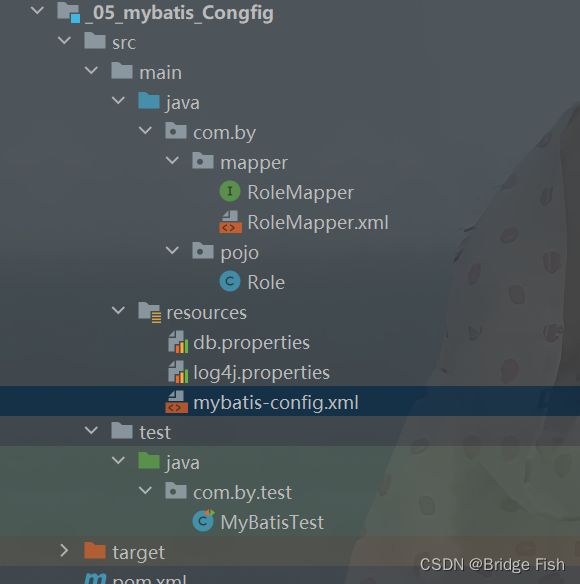MyBatis的配置文件
目录
MyBatis配置
1.properties标签
2.typeAliases标签
3.Mappers标签
一个最全面的MyBatis配置文件可能会包含各种不同的设置和选项,根据实际情况,可以根据需要添加或删除配置。以下是一个包含各种可能设置的示例。
这个配置文件包含了环境设置、数据源配置、映射器配置、属性配置、类型别名、类型处理器、全局设置以及插件配置。根据具体需求,可以根据这个模板添加或删除配置项,并根据需要进行调整。不同项目的配置可能会有所不同,所以可以根据实际情况灵活调整。
更多设置项请参考官方文档mybatis – MyBatis 3 | Configuration
MyBatis配置
1.properties标签
在MyBatis的配置文件中,
标签用于定义属性,这些属性可以在配置文件中多处引用,使得配置更加灵活和易于维护。它允许你定义一些可重复使用的值,并在其他地方引用这些值
基本结构
两种用法:
1.使用外部资源:使用 resource 属性引用外部属性文件(如 .properties 文件)
这样做的好处在于可以将配置的属性值存储在一个单独的文件中,使得配置文件更加清晰和易于管理。
2.直接定义属性:直接在
这种方式允许你在配置文件内部定义属性,以供后续引用和使用。
然后,你可以在配置文件的其他地方通过 ${propertyName} 的形式来引用这些属性值。例如:
db.properties
jdbc.driver=com.mysql.jdbc.Driver
jdbc.url=jdbc:mysql://127.0.0.1:3305/mybatis?characterEncoding=UTF-8
jdbc.username=root
jdbc.password=在mybatis-config.xml引入数据库配置信息
2.typeAliases标签
标签在MyBatis配置文件中用于定义类型别名,它允许你为Java类型指定简短的别名,以在MyBatis映射文件中引用这些类型。
基本结构
其中:
alias属性用于定义你想要使用的别名。type属性指定了对应的Java类型的完全限定名。
查看mybatis源码可以看到 Mybatis 默认支持的别名:
public TypeAliasRegistry() {
this.registerAlias("string", String.class);
this.registerAlias("byte", Byte.class);
this.registerAlias("long", Long.class);
this.registerAlias("short", Short.class);
this.registerAlias("int", Integer.class);
this.registerAlias("integer", Integer.class);
this.registerAlias("double", Double.class);
this.registerAlias("float", Float.class);
this.registerAlias("boolean", Boolean.class);
this.registerAlias("byte[]", Byte[].class);
this.registerAlias("long[]", Long[].class);
this.registerAlias("short[]", Short[].class);
this.registerAlias("int[]", Integer[].class);
this.registerAlias("integer[]", Integer[].class);
this.registerAlias("double[]", Double[].class);
this.registerAlias("float[]", Float[].class);
this.registerAlias("boolean[]", Boolean[].class);
this.registerAlias("_byte", Byte.TYPE);
this.registerAlias("_long", Long.TYPE);
this.registerAlias("_short", Short.TYPE);
this.registerAlias("_int", Integer.TYPE);
this.registerAlias("_integer", Integer.TYPE);
this.registerAlias("_double", Double.TYPE);
this.registerAlias("_float", Float.TYPE);
this.registerAlias("_boolean", Boolean.TYPE);
this.registerAlias("_byte[]", byte[].class);
this.registerAlias("_long[]", long[].class);
this.registerAlias("_short[]", short[].class);
this.registerAlias("_int[]", int[].class);
this.registerAlias("_integer[]", int[].class);
this.registerAlias("_double[]", double[].class);
this.registerAlias("_float[]", float[].class);
this.registerAlias("_boolean[]", boolean[].class);
this.registerAlias("date", Date.class);
this.registerAlias("decimal", BigDecimal.class);
this.registerAlias("bigdecimal", BigDecimal.class);
this.registerAlias("biginteger", BigInteger.class);
this.registerAlias("object", Object.class);
this.registerAlias("date[]", Date[].class);
this.registerAlias("decimal[]", BigDecimal[].class);
this.registerAlias("bigdecimal[]", BigDecimal[].class);
this.registerAlias("biginteger[]", BigInteger[].class);
this.registerAlias("object[]", Object[].class);
this.registerAlias("map", Map.class);
this.registerAlias("hashmap", HashMap.class);
this.registerAlias("list", List.class);
this.registerAlias("arraylist", ArrayList.class);
this.registerAlias("collection", Collection.class);
this.registerAlias("iterator", Iterator.class);
this.registerAlias("ResultSet", ResultSet.class);
}
例如,假设有一个Java类 com.example.Author,你可以在
这样,在MyBatis映射文件中就可以使用 Author 作为 com.example.Author 类的别名。
也可以使用包名来注册别名,这样就能够批量注册某个包下所有类的别名,如下所示:
这将注册 com.example.models 包下所有类的别名,别名默认使用类名(不区分大小写)。例如,com.example.models.Author 类可以直接在映射文件中使用别名 Author。
3.Mappers标签
标签是用于配置MyBatis映射器(Mapper)的标签,在MyBatis的配置文件中用于指定映射器文件的位置或者扫描映射器的包名。这个标签可以包含多个子标签,每个子标签可以是
、或。
Mappers标签的作用是用来在核心配置文件里面引入映射文件,引入方式有如下三种:
1.使用mapper映射文件的路径
2.使用mapper接口的路径
注意:此种方法要求 mapper 接口名称和 mapper 映射文件名称相同
3.使用mapper接口的包名批量引入
注意:此种方法要求 mapper 接口名称和 mapper 映射文件名称相同
